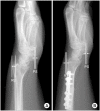Long-term outcomes of ulnar shortening osteotomy for idiopathic ulnar impaction syndrome: at least 5-years follow-up
- PMID: 22162792
- PMCID: PMC3232357
- DOI: 10.4055/cios.2011.3.4.295
Long-term outcomes of ulnar shortening osteotomy for idiopathic ulnar impaction syndrome: at least 5-years follow-up
Abstract
Background: There have been few outcomes studies with follow-up after performing ulnar shortening osteotomy for ulnar impaction syndrome. We investigated the long-term clinical and radiological outcomes of ulnar shortening osteotomy for the treatment of idiopathic ulnar impaction syndrome.
Methods: We retrospectively reviewed 36 patients who had undergone ulnar shortening osteotomy for idiopathic ulnar impaction syndrome for a mean follow-up of 79.1 months (range, 62 to 132 months). The modified Gartland and Werley scores were measured pre- and postoperatively. The radiographic parameters for the assessment of the distal radioulnar joint (DRUJ) as well as the relationship between these radiographic parameters and the clinical and radiological outcomes were determined.
Results: The average modified Gartland and Werley wrist score improved from 65.5 ± 8.1 preoperatively to 93.4 ± 5.8 at the last follow-up visit. The average preoperative ulnar variance of 4.7 ± 2.0 mm was reduced to an average of -0.6 ± 1.4 mm postoperatively. Osteoarthritic changes of the DRUJ were first seen at 34.8 ± 11.1 months follow-up in 6 of 36 wrists (16.7%). Those who had osteoarthritic changes in the DRUJ had significantly wider preoperative ulnar variance, a longer distal radioulnar distance and a greater length of ulnar shortening, but the wrist scores of the patients who had osteoarthritic changes in the DRUJ were comparable to those who did not have osteoarthritic changes in the DRUJ.
Conclusions: The clinical outcomes are satisfactory for even more than 5 years after ulnar shortening osteotomy for treating idiopathic ulnar impaction syndrome despite the osteoarthritic changes of the DRUJ. The patients who need a larger degree of ulnar shortening may develop DRUJ arthritis.
Keywords: Distal radioulnar joint; Idiopathic ulnar impaction syndrome; Long-term outcome; Osteoarthritis; Ulnar shortening osteotomy.
Conflict of interest statement
No potential conflict of interest relevant to this article was reported.
Figures




References
-
- Friedman SL, Palmer AK, Short WH, Levinsohn EM, Halperin LS. The change in ulnar variance with grip. J Hand Surg Am. 1993;18(4):713–716. - PubMed
-
- Palmer AK, Glisson RR, Werner FW. Ulnar variance determination. J Hand Surg Am. 1982;7(4):376–379. - PubMed
-
- Baek GH, Chung MS, Lee YH, Gong HS, Lee S, Kim HH. Ulnar shortening osteotomy in idiopathic ulnar impaction syndrome. J Bone Joint Surg Am. 2005;87(12):2649–2654. - PubMed
-
- Minami A, Kato H. Ulnar shortening for triangular fibrocartilage complex tears associated with ulnar positive variance. J Hand Surg Am. 1998;23(5):904–908. - PubMed
-
- Chun S, Palmer AK. The ulnar impaction syndrome: follow-up of ulnar shortening osteotomy. J Hand Surg Am. 1993;18(1):46–53. - PubMed
Publication types
MeSH terms
LinkOut - more resources
Full Text Sources
Medical

